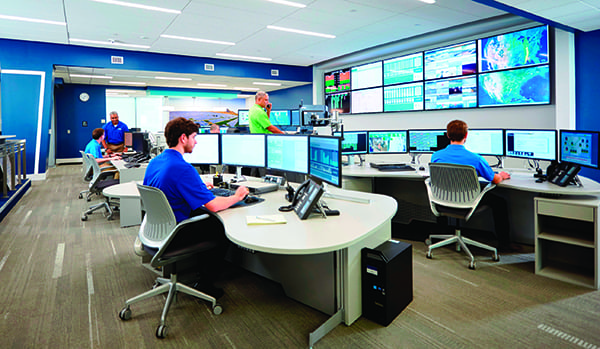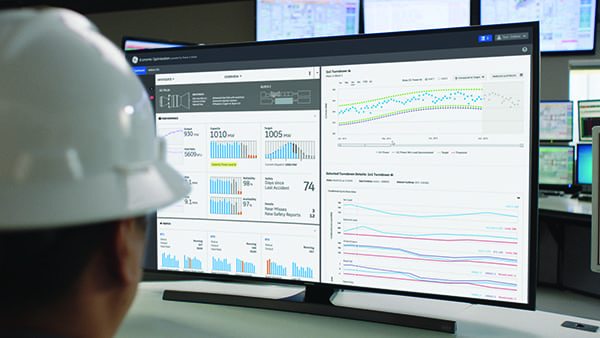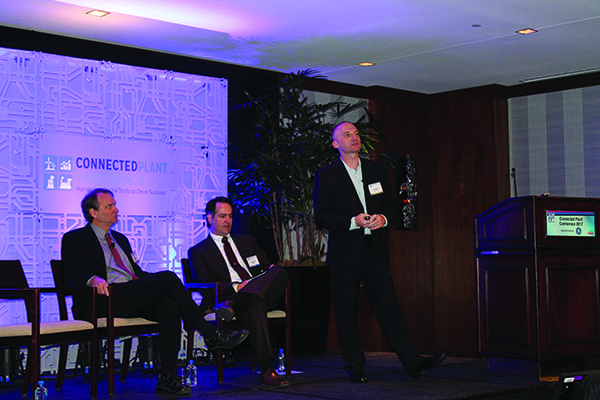The Future Is Now: Connected Power Plants Are Here
 New technology is being used throughout the power industry to improve plant efficiency, predict trouble with degrading equipment, forecast weather trends, and train workers. A recent conference hosted by POWER brought together a number of savvy users and providers to share their experiences and learn about new offerings.
New technology is being used throughout the power industry to improve plant efficiency, predict trouble with degrading equipment, forecast weather trends, and train workers. A recent conference hosted by POWER brought together a number of savvy users and providers to share their experiences and learn about new offerings.
A joke that always seems to get laughs when the power plant of the future is contemplated is that only one human and one dog will be needed to operate it. The dog's job will be to bite the human if he or she tries to touch anything; the human's job will be to feed the dog.
The point of the joke, of course, is that the power plant of the future may not need humans at all; it may be run completely by computers and controlled using artificial intelligence. Although that sounds like science fiction, so did self-driving cars a few years ago. Now, it's not only companies like Tesla and Google that are developing autonomous vehicles; even Ford expects to have commercial models available by 2021.
Leaders ConnectPOWER hosted the first-ever Connected Plant Conference in Dallas, Texas, February 15-16, 2017. The conference-designed to give attendees the tools needed to move toward a more connected power plant-was sponsored by industry heavyweights GE, Siemens, and the Electric Power Research Institute (EPRI), among others. Presentations included case studies on connected technologies being utilized by utilities such as Exelon, Duke Energy, Salt River Project, and more. (Stay tuned to POWER for soon-to-be-released details about next year's event.)
During the conference, Sham Chotai, chief technology officer (CTO) of GE Power Digital Solutions, noted that technology offerings have evolved significantly in recent years (Figure 1). GE introduced its digital wind farm in the spring of 2015. The solution has improved the annual energy production of some wind farms by 3% to 4% through digital modeling and improved data analytics. In the fall of 2015, GE rolled out its digital power plant for gas-fired facilities, increasing the efficiency of many of those units. Last summer, it introduced the digital power plant for steam units, which has improved the efficiency of some coal-fired plants by 5%.
 |
| 1. The digital revolution. New technology, such as GE's Predix system, has allowed many power plants to optimize performance. Courtesy: GE Power |
Chotai noted that Exelon Generation has embraced GE's Predix technology in a big way. For example, Exelon is utilizing the product's energy forecasting tools to more accurately predict wind speeds, which affects wind generation forecasts. Dispatchers use the information to adjust models and factor in expected changes. One Exelon employee said prior to implementing the Predix solution, the company left potential energy generation on the table that it is now able to profit from.
"[Exelon is] just an incredible, incredible partner for us," Chotai said. "They're early adopters. We think we're early in this journey. We spent about the last 18 months really piloting a lot of technologies" They bought everything that we had."
Another example of an early adopter is Duke Energy (the company's Renewable Control Center is shown in the opening photo). Michael Reid, general manager of technical programs for Duke Energy's Fossil Hydro Group, gave a presentation showing how Duke Energy has applied technology-building off the online-monitoring concept-to detect equipment failures earlier than was previously possible. He noted that the earlier problems are detected, the more time there is to plan, prioritize, schedule, and execute repairs.
Although a common perception is that equipment wears out over time, Reid said most equipment failure occurs randomly. That fact offers an opportunity for companies with a proactive mindset. Duke Energy has added more and more field sensors to monitor plant components with the goal of avoiding catastrophic breakdown. It now acquires much more data than it used to, and it exploits that data to detect potential problems. One game changer was the ability to utilize wireless connectivity.
"We have many sensors applied on our assets. They're hardwired to numerous data acquisition systems around the station. Those data acquisition computers then send information to the plant server wirelessly," Reid explained. "If we didn't have that architecture, it would be far too expensive to install this, because really 75% of the cost of the project is related to installation of the wiring for the sensors-and that's just for a very short distance to these computers."
Reid said thoroughly reviewing all of the data that is collected is not humanly possible, so Duke Energy has several software tools that it utilizes for the task. The company has created virtual plant models-Duke Energy currently has more than 10,000 models-and it monitors thermal performance at plants looking for optimization opportunities and other issues.
"Once we have alarms going off and telling us, this is not expected behavior, then we have our experts start to dig into this problem and use the tools that we have," Reid said.
One "find," or situation in which a plant needed to take action based on the monitoring team's analysis, resulted in the discovery of a very large crack in a high-pressure steam turbine rotor. Although the team could not pinpoint the exact problem while the unit was online, pattern recognition software identified a vibration anomaly that had gone undetected by control room operators. After further analysis, the team determined that a thorough examination was warranted. The unit was shut down, avoiding catastrophic failure, and the crack was found during the inspection.
Duke Energy's Monitoring and Diagnostics Center reported 555 finds from 2013 through 2016. The company estimates that the center has more than paid for itself through cost avoidance attributable to the center's finds during the period.
Modeling Plants Pays DividendsRandy Bickford, president and CTO of software firm Expert Microsystems, agreed that modeling expected performance parameters is key. "The most accurate expected values give you the earliest and most accurate predictions of potential problems," he said. Without a good model, it's much harder to use plant data effectively. One problem with relying directly on sensor data is that many problems can display the same symptoms, making it hard to tell what's really going on. "With that model, you know when and where problems will occur."
Stefan Bungart, global head of digitalization, power generation services for Siemens Energy, noted that utilities that have embraced the possibilities of digitization have seen returns across their entire operations, from generation and distribution, to trading, retail, and even headquarters overhead. Digitization can improve plant security, network security, and system integrity, he noted.
Andrew Johnson, supervisor of Salt River Project's (SRP's) Performance Monitoring Center (PMC) in Arizona, reported similar benefits from the cooperative's embrace of advanced predictive analytics. The project began with one combined cycle plant in 2005, and SRP has since rolled it out across its entire fleet, expanding the range of data it gathers over time. The PMC is staffed by a crew of experienced plant supervisors who are able to give expert advice to plant workers remotely. The results have more than justified the substantial investment.
"In 2016, the PMC managed 318 saves," Johnson said.
SRP plans to expand the PMC's capabilities through additional advanced modeling of performance and vibrational data.
Using Data to Optimize Your PlantOne area that big data and advanced monitoring can help with is environmental compliance, two speakers noted. Philip Black, product marketing director with the Wood Group, pointed out that noncompliance has become more costly, and that the Environmental Protection Agency expects plant compliance data to be much more accessible than it has been in the past (Figure 2). That means the old spreadsheet approach is often no longer enough.
"You can't afford to have a bunch of different sets of data sets for your compliance. You can't have Operations looking at one set of data, Environmental collecting that data manually, and then sending it to Management," he said. "Operations needs that same data and same information."
But having a connected plant means operators can run equipment based on actual values instead of estimates, and it allows for a more consistent, predictable approach that can prevent problems before they occur, he said. Properly configured systems will identify data loss instead of relying on faulty instrumentation that can throw off results. All of this allows for more efficient operations and better decision-making.
"You get the ability to start using your compliance data as a dataset, as a consistent set of information in a format that everyone can access and use," he said. "It's not just the right data to the right person. It's the right data into the right system."
One especially powerful tool is using these rich historical datasets for failure analysis, so that the plant has a clear picture of exactly what went wrong, where, and why.
"It gives us the ability to move the information from static reports into visual and other representations to show where the failures occurred," he said.
Advanced neural net modeling and rich data can allow for real-time, closed-loop combustion optimization, Steve Piche, software director with GE Power Digital Services, explained. Earlier generations of neural net models could only predict current or changing values in emissions data due to changes in manipulated variables. The most recent generation, however, can not only predict changes, but also predict levels of confidence in the new values based on those variables. This allows for much more precise tuning of combustion, he said, because the predicted confidence values can be used to evaluate the quality of the models.
"What this allows us to do is understand what inputs are affecting what outputs, and how strongly they are affecting the outputs, and do we need to collect additional data."
Piche described a case study involving a two-unit, 730-MW coal plant that needed to significantly reduce its NOx emissions to avoid a substantial derate. Using GE predictive analytics and optimization, the plant was able to achieve a 10% NOx reduction over a 45-day period and continue operating at its rated capacity.
Vigilance Is Vital for CybersecurityBringing a power plant into the age of the Industrial Internet of Things (IIoT) inherently raises cybersecurity concerns. As more connections are made between a plant's many systems, more access points are naturally created for hackers to gain entry, Marina Krotofill, lead security researcher at Honeywell Industrial Cyber Security, explained during the conference.
"The Internet of Things means that you introduce some sort of connectivity to your platform," she said. "If you introduce external connectivity from the internet, you have to make sure that your infrastructure is secure."
While there are undeniably potential security risks related to connecting a power plant's systems, that should not necessarily be a deterrent to doing so, according to Mark Carrigan, COO of PAS Inc. The potential benefits of integrating IIoT technology into a plant's operation can outweigh the cybersecurity risks, as long as the plant operator addresses the risks, he said.
"One of the big things about cybersecurity is you can't quantify the risks like you can other things. In some ways, for some people, it's like it's just out there," he said. "The reality is: There have been a number of successful attacks on industrial control systems in the power industry specifically. That 'head-in-the-sand' [mentality] is probably not going to work anymore."
One of the keys to guarding a plant against potential cyberattacks is understanding where vulnerabilities lie. "You're opening up more of these paths, and as you open it up in one direction, you're creating another direction back in for the bad guys," Carrigan said. "The other thing is: These things have a day job. Engineers are constantly making changes in [distributed control systems (DCSs)] and [programmable logic controllers (PLCs)] to improve operations, and that's a good thing, but they can do two things inadvertently while they're doing that."
First, Carrigan continued, in making changes to a once-secure DCS or PLC, engineers can damage the data those systems are sending to the IIoT. "Second thing I can do is I can open up more security holes because I have done something" all of sudden I've opened up a path I didn't expect to be there or I've created a vulnerability I didn't want. All of a sudden I've left my system more vulnerable," he said.
Enhancing Efficiency and Worker Safety with TechnologyBecause the global population is anticipated to surpass eight billion people by 2025 and the world will need to produce more essentials, including medicine, food, water, and especially energy, the industrial sector must become smarter and more productive, argued Tom McDonnell, power generation industry leader at Rockwell Automation. This digital transformation is already under way.
"Applications and systems-such as integrated, intelligent electrical devices and smart instrumentation-can be unified, resulting in speedy data analysis for richer insight and better decision-making," he said.
On the power plant construction and design front, digital technology can make a positive impact on cost and risk. "This integrated digital structure requires less control system interwiring, less engineering detail on drawings, less hardware, less fabrication wiring, and fewer points to test. This helps reduce costs across the entire lifecycle of the plant control system," McDonnell noted. "This can be hundreds of thousands of dollars for a mid-size project."
Safety, too, can be integrated into the digital culture. The electronic integration of safety could improve procedural compliance, the safety audit process, safety program tracking, safety event tracking, and safety system monitoring. Additionally, it could identify trends by determining the root cause of safety events, as well as cut downtime caused by safety events, he said.
Finally, the digital integration of safety could benefit younger, less-experienced workers who may need time to fully understand an organization's safety culture. "Safety procedures, culture, and processes do not change regardless of the employee's generation," McDonnell added.
Matt Buck, who is a senior technical leader for EPRI, pointed out that in 2015 Millennials became the greatest percentage of the workforce. Born between 1980 and 2000, that generation has "different career expectations" and "grew up with electronics and interconnectedness as part of their everyday life." The digital transformation is inevitable, he argued. But he said there is a more significant question worth exploring: Whether the use of technology will be enterprise-driven or motivated by employees seeking to "find a way"?
Transitioning to a digital workforce will require the "right approach," from the "right application of technology to the right 'app' to get the job done," Buck said. These applications should increase efficiency and effectiveness, but they must also enhance worker safety and productivity, and cannot risk situational awareness or be overly complicated (Figure 3). Finally, they should be developed with the involvement of field workers to have value, he said.
Some helpful applications under development include wearable biometric monitoring to improve employee health; geolocation or scanning to aid in equipment identification; trend overlays to gauge real-time equipment status; and virtual walkthroughs before execution of a procedure. a-
-Abby L. Harveyis reporter,Aaron Larsonis executive editor, andThomas W. OvertonandSonal Patelare associate editors for POWER magazine.
The post The Future Is Now: Connected Power Plants Are Here appeared first on POWER Magazine.

